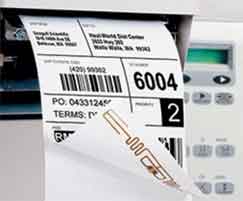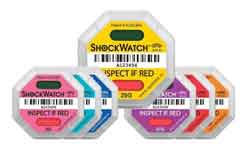Below are three of the top stories in automated data collection and RFID in recent weeks.
RFID, AIDC and IoT News: GS1 Issues Statement on Bar Codes and Country of Origin
GS1 US, information standards organization and administrator of the Universal Product Code (UPC), recently issued a formal statement to confirm that the product identification numbers within a UPC bar code (or EAN for Europe) on product packaging do not indicate a product's
country of origin.
"Inaccurate social media posts claiming that UPC bar codes can identify where a product was produced have gone viral in recent weeks. While the first three numbers encoded within a UPC may correlate to the country in which a brand operates, they do not signify the location where a product was manufactured," says Carrie Wilkie, senior vice president of enterprise program delivery, GS1 US. "We understand there's heightened interest among shoppers to understand where products are made, but GS1 member companies can manufacture products anywhere in the world and the UPC in use today does not provide that level of detail for consumers."
Supply Chain Digest Says... |
 |
| "While Impinj trades cheaper, Avery Dennison has the leverage and market share to dominate this digital transformation," Markman writes. |
 |
What do you say? |
| Click here to send us your comments |
 |
| Click here to see reader feedback |
|
|
UPC bar codes contain a GS1 Global Trade Item Number (GTIN), a sequence of numbers usually also printed under the bar code symbol that uniquely identifies a product at the SKU level in the supply chain.
To create GTINs, brands must first secure a GS1 Company Prefix that globally identifies their company in the supply chain and links their products to their brand. An authentic GS1 Company Prefix is acquired through a license agreement with GS1 US or any other GS1 member organization around the globe.
Once the GS1 Company Prefix is secured, brands create their own GTINs, by combining their GS1 Company Prefix with a unique product number that they assign. The GS1 Company Prefix reflects the country from which a Prefix was licensed—often, but not always, reflecting the location of the company headquarters.
But a given item with a GTIN could come from a different country, and indeed products with a given GTIN could be sourced from multiple countries.
All that said, GS1 expects the UPC to phase out in the next few years in favor of two-dimensional (2D) bar code symbologies such as the QR Code or GS1 DataMatrix, digital watermarks (e.g., Digimarc), and/or radio frequency identification (RFID), all of which can provide more information, including country of origin.
RFID Company Impinj has Blowout Q1 on Virus Crisis Stock Ups
Seattle-based company Impinj, the leading provider of RFID readers and tags, posted a record $47.8 million in revenue for the first quarter, up nearly 45%, even as the COVID-19 crisis closed stores around the world.
What happened? Some Impinj customers placed large given the uncertainty around the virus crisis. That order surge at the end of March, was responsible for $6.2 million in unanticipated shipments, the company told analysts and investors on a conference in early May.
Nevertheless, Impinj remained cautious around its Q2 numbers, citing "unprecedented economic upheaval" from the COVID-19 crisis, but acknowledged that the fallout from the pandemic will impact its profitability in the near term, and said it will keep a close eye on discretionary spending.
While the prevailing sentiment is negative, particularly in retail, aviation and automotive, there are bright spots as well, such as in omnichannel retail and supply chain and logistics," said Chris Diorio, Impinj CEO and co-founder.
For the March quarter, the company posted a net loss of $4.3 million, an improvement over its net loss of more than $7 million a year earlier.
(See More Below)
|
CATEGORY SPONSOR: SOFTEON |
|
|
| |
|
|
During the conference call, Diorio noted that retail apparel consumed "more than half" of all RFID chips worldwide, and that retailers that tethered their inventories to RFID systems were "better positioned to sell online than their competitors who are not," and that disparity would boost market demand over "the long term."
Forbes Columnist Says Avery Dennison Better Stock Buy than Impinj
Investors have been on a roller-coaster since Impinj went public in 2017, but given its position it would seem to be a stock worth taking a look at, though not for the feint of heart.
 However, Jon Markman, who writes a technology column for Forbes.com, thinks he has a better idea to profit from the expected growth in RFID: Avery Dennison. However, Jon Markman, who writes a technology column for Forbes.com, thinks he has a better idea to profit from the expected growth in RFID: Avery Dennison.
"While Impinj trades cheaper, Avery Dennison has the leverage and market share to dominate this digital transformation," Markman writes.
He said the company is best known for making the labels used by the consumer products and packaging sectors. For some time, the California company has also moved aggressively into RFID.
For example Avery Dennison acquired Smartrac, the world's largest maker of RFID inlays used in ePassports, sast November. A month later, the company broke ground on a new manufacturing facility in Brazil. Markman says Avery Denison now controls more than 1,000 RFID patents and is well-positioned to leverage its relationships with leading consumer brands.
Markman also cites a pilot program the company started with Ralph Lauren in November 2019. Printed tags attached to the label inside shirts, pants and other garments contain a digital tag, according to a story published in Women's Wear Daily. The tags give the clothing a purely digital identity that make inventory tracking and offering better post-sale customer experiences a snap.
"Shares trade at 16x forward earnings and 1.4x sales. The stock is currently having a big correction. It looks like a buy on this pullback for patient value investors," Markman notes.
Any reaction to the stories in this week's roundup? Let us know your thoughts at the Feedback section below.
Your Comments/Feedback
|

